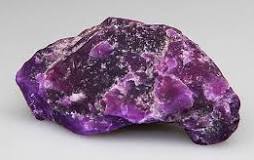
Sugilite: Unveiling the Purple Healer
🌍 1. Geological Profile of Sugilite
Sugilite is a rare cyclosilicate mineral, primarily composed of potassium, sodium, lithium, iron, manganese, aluminium, and silicate. Its chemical formula is KNa₂(Li, Fe²⁺, Mn²⁺)₂ Si₈O₂₂(OH)₂. Forming in metamorphosed manganese deposits, it exhibits a trigonal crystal structure but is most often found as massive aggregates rather than distinct crystals.
-
Colour & Appearance: The hallmark hue ranges from lavender to deep purple, occasionally showing hints of pink or reddish tones. Variations include uniform mauves and mottled purple–black masses.
-
Hardness & Density: With a Mohs hardness of approximately 6–6.5, sugilite is fairly durable—yet still softer than many mainstream gemstones. Its specific gravity lies between 2.75 and 2.80.
-
Notable Origins: The mineral was first identified in Iwagi Islet, Japan, in 1944 and later found in South Africa’s Wessels Mine—now the world's primary supply. Other occurrences include Canada and Italy, though in much smaller quantities.
✨ 2. Energetic Meaning & Healing Applications
Sugilite is often referred to as the “healer’s stone” or the “love stone of spiritual transformation.” Among crystal therapy enthusiasts, it’s reputed to:
-
Amplify emotional healing and release karmic stress
-
Enhance spiritual connection and inner peace
-
Support purification, promoting alignment of mind, body, and spirit
Practitioners frequently use sugilite during meditation, placing it on the third eye or heart chakra to alleviate anxiety, inner conflict, and grief. Some believe it aids emotional resilience and clarity.

💎 3. Rarity & Aesthetic Uniqueness
Sugilite ranks among the most cherished semi-precious minerals, both for its limited sources and striking purple shades.
-
Scarcity: High-grade sugilite—rich, uniform purple without matrix inclusions—is uncommon, especially in large pieces.
-
Distinctiveness: No two pieces are alike; the stone may exhibit deep, saturated colour, or intricate patterns featuring black manganese spots.
-
Natural vs Treated: The market offers polished cabochons and beads, along with rough specimens. Collectors often prize raw forms with untouched surfaces and natural edges, believing these preserve the stone’s energetic purity.
🔍 4. Comparison with Other Purple Stones
While sugilite shares violet hues with crystals like amethyst and charoite, it remains distinct in many respects:
| Mineral | Colour Range | Hardness | Rarity | Energy Focus |
|---|---|---|---|---|
| Sugilite | Lavender to deep purple | 6–6.5 | High | Emotional healing, spiritual calm |
| Amethyst | Light to deep violet | 7 | Medium | Intuition, protection, sobriety |
| Charcoalite | Swirled purple fibres | 5–6 | High | Transformation, inner strength |
| Lepidolite | Lilac, pink | 2.5–3 | Medium | Emotional balance, lithium healing |
Sugilite tends towards richer violet tones than the clear crystalline hue of amethyst and carries a smoother, more earthy aspect than charoite. While lepidolite is noticeably softer and more pastel, sugilite offers a balance of depth and durability.
🧿 5. Use in Adornment: Raw & Polished
In fine jewellery—particularly artisan creations focusing on raw crystal jewellery—sugilite is gaining popularity.
-
Raw Crystal Jewelry: Designers occasionally highlight sugilite in its natural form, sometimes with native manganese matrix—ideal for low-profile mineral specimen necklaces or statement pendants.
-
Crystal Specimen Rings & Necklaces: Carefully cut cabochons emphasise colour saturation, set in silver or white gold to contrast and enhance the purple tones.
-
Handmade Gemstone Ring Appeal: Though less robust for everyday wear than quartz, sugilite lends rich, emotional depth to unique rings meant for occasional adornment or spiritual intention.

📚 6. Historical Lore & Cultural Associations
Though sugilite’s official discovery is relatively recent—mid-20th century—it quickly captivated spiritual seekers and collectors. Some crystal lore interprets its vivid violet hue as symbolising “divine love” or “cosmic light.” In metaphysical circles, it is associated with the Age of Aquarius, a period believed to herald spiritual awakening and higher consciousness.
Certain esoteric traditions consider sugilite a guardian stone for sensitive souls or indigo children—those who may feel spiritually attuned or energetically porous. Healers in both the East and West have embraced its potential for energetic shielding, often pairing it with black tourmaline or hematite for added grounding.
💼 7. Collectible Value & Investment
Sugilite’s status in the world of raw crystal collectors and mineral specimen jewellery is steadily rising. Several factors influence its desirability:
-
Geological Rarity: With the primary source—South Africa’s Wessels Mine—now producing very little, sugilite’s availability is becoming increasingly limited.
-
Colour & Purity: Deep grape to royal purple hues fetch higher prices, especially in raw or minimally processed formations.
-
Natural Matrix Inclusions: Some collectors seek sugilite with manganese or black matrix veins for added geological interest.
Because of its scarcity, larger raw pieces or high-quality cabochons are becoming valued not just as adornments, but as crystal investments.
🧵 8. Oryssia’s Approach to Sugilite
At Oryssia, we understand that a crystal is not just a stone—it’s a companion, an anchor, and a piece of Earth’s ancient story.
In our mineral specimen jewellery designs, sugilite is offered both as an unrefined fragment and as part of intuitive adornments that reflect its soft power. Our crystal specimen rings and raw gemstone pendants often showcase the natural curves, hues, and textures of the stone, allowing the violet tones to speak for themselves.
We believe that those who choose sugilite are already in deep dialogue with their own spiritual evolution. Our offerings aim to honour that connection—softly, reverently, and with soul.